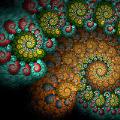
DMT-Nexus member
Posts: 66 Joined: 06-May-2013 Last visit: 06-Jan-2015
|
The first earth-seze planet to be found in the habitable zone around another star. The planet is called Kepler-186f and is about 10% larger than earth with a mean surface temperature a bit above 0 degrees celsius which means water will be a liquid if there is enough atmospheric pressure. It is about 500 lightyears away which means that it would take about 15000000 years to reach it with one of todays rockets. Here is a link to the NASA article: http://www.nasa.gov/ames.../index.html#.U1GSj1V_u2EFinding a planet that is as small as earth is very difficult and we are only able to find planets around a small fraction of stars in the galaxy so it is likely that planets with caracteristics that we associate with life are actually very common in the universe.
|
|
|
|
|

.

Posts: 6739 Joined: 13-Apr-2009 Last visit: 10-Apr-2022
|
Remember this article last year? http://www.npr.org/blogs...ke-planets-in-our-galaxyThey estimate that the number of stars that could have earth-like planets in our galaxy alone is 22%
|
|
|

☂

Posts: 5257 Joined: 29-Jul-2009 Last visit: 19-Jul-2025 Location: 🌊
|
I think that in some ways the "habitable zone" is in reality way beyond what our narrow assumptions currently permit. For example just look at these moons made of ice, with oceans within them that many now think could possibly harbor life. This whole thing is just such a new area that it's pretty much in the dark ages at this point...Our guesses on the parameters that limit the emergence of life are so much a product of our own earth environment that I think we would be astonished to see what kind of "extreme" planetary conditions life can emerge and survive on.
<Ringworm>hehehe, it's all fun and games till someone loses an "I"
|
|
|

DMT-Nexus member
Posts: 66 Joined: 06-May-2013 Last visit: 06-Jan-2015
|
universecannon wrote:I think that in some ways the "habitable zone" is in reality way beyond what our narrow assumptions currently permit. For example just look at these moons made of ice, with oceans within them that many now think could possibly harbor life.
This whole thing is just such a new area that it's pretty much in the dark ages at this point...Our guesses on the parameters that limit the emergence of life are so much a product of our own earth environment that I think we would be astonished to see what kind of "extreme" planetary conditions life can emerge and survive on. This is true. I remember a question on an exam in for a course in astrobiology that I took a couple of years ago: "Discuss the possibilities of life on a rogue planet" (rogue planet = a planet that is not orbiting a star but is moving freely in space) and it is fully possible for microbial life to thrive on such a planet if there is enough radioactive material to heat up the core. Possibly life could live outside of the "habitable zone" in an ocean under a thick layer of ice or maybe life can be based on a solvent with a lower or higher freezing point than water. Like liquid nitrogen or methane. Still so far among the planets and moons that we have observed in our solarsystem life has been observed only on one so I think it is a good bet to spend the rather limited amount of money available for this type of research on finding planets that are as similar to earth as possible.
|
|
|

☂

Posts: 5257 Joined: 29-Jul-2009 Last visit: 19-Jul-2025 Location: 🌊
|
bluesky wrote:
Still so far among the planets and moons that we have observed in our solarsystem life has been observed only on one so I think it is a good bet to spend the rather limited amount of money available for this type of research on finding planets that are as similar to earth as possible.
Certainly I've also always felt that if we took even a fraction of the money we spent on this sort of thing (or the military industrial complex, etc) and instead spent it on consciousness research involving psychedelics, we would make some astonishing discoveries that have profound implications, perhaps even in regards to life in others world  . Who knows. But that's not to say that I don't think we should investigate this, obviously.
<Ringworm>hehehe, it's all fun and games till someone loses an "I"
|
|
|

DMT-Nexus member
 
Posts: 3968 Joined: 21-Jul-2012 Last visit: 15-Feb-2024
|
The paradigm that life is precious and rare is being replaced with one that states that life is ubiquitous. Quite a radical change of thought. Just like there being large quantities of water on the moon, mars and elsewhere, when just a few years ago that would have been considered absurd.  Sine experientia nihil sufficienter sciri potest -Roger Bacon
*γνῶθι σεαυτόν*
|
|
|

DMT-Nexus member
Posts: 711 Joined: 22-Jan-2012 Last visit: 10-Mar-2023
|
Different, maybe. But read this one last march. Pretty neat stuff isn't it? http://www.dailygalaxy.c...tars-habitable-zone.htmlSpecifically the last paragraphs I thought were fascinating: Quote:In summary, he found that UV radiation actually split molecules of oxygen to create more ozone than it destroyed. The simulation made a thicker ozone layer in the planetary atmosphere such that the surface experienced no more radiation than is typical on a sunny day on Earth. What’s more, as the dwarf settles down to a quiescent existence, there would be very little ultraviolet light and an UV filtering ozone layer would not even be needed.
However, potentially habitable red dwarf planets may keep one hemisphere locked onto their star due to gravitational tidal forces. The resulting slow rotation may give them anaemic magnetic fields that do not block cosmic rays effectively.
The answers may be coming soon via the James Webb Space Telescope, which has been re-scheduled for launch in 2018, would be used to spectroscopically 'sniff' out the exoplanet's atmosphere for chemistry that might be a by-product of organisms on the surface. If these planets develop a natural UV shield, then the discovery of an inhabited world may be no more than a decade away. I think what is meant when they refer to the goldilocks, or habitable zone is the conditions for life relatively similar to that found on our own planet, and 'intelligent' as it were.
|